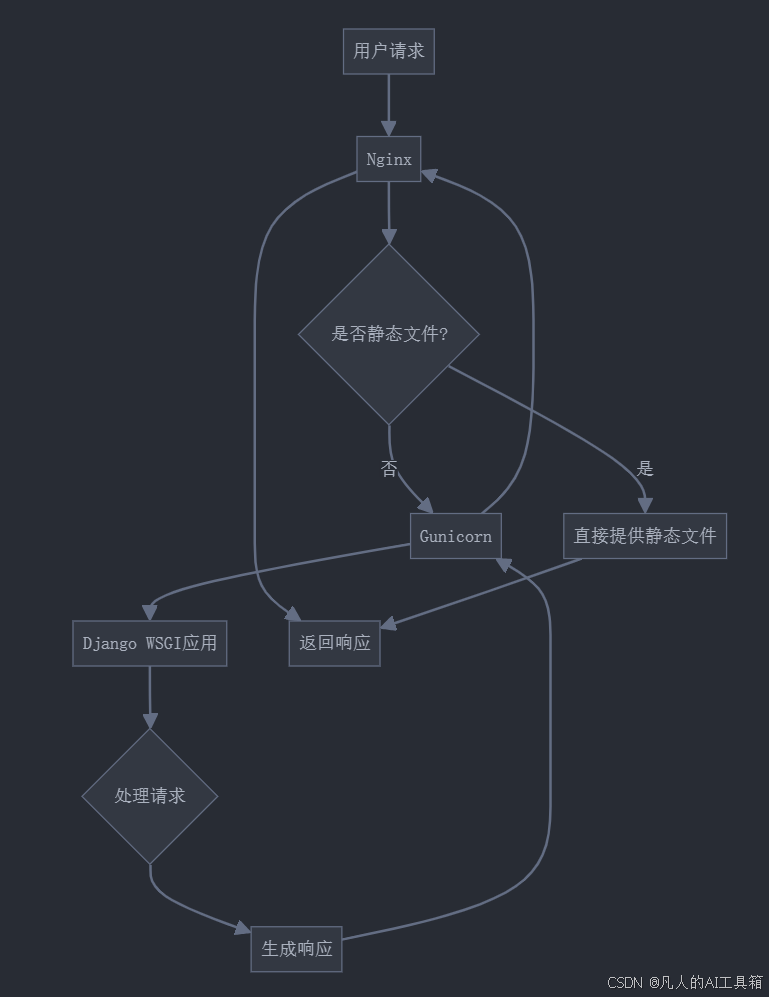Django部署
一、今日学习内容概述
| 学习模块 | 重要程度 | 主要内容 |
|---|---|---|
| 生产环境配置 | ⭐⭐⭐⭐⭐ | settings配置、环境变量 |
| WSGI服务器 | ⭐⭐⭐⭐⭐ | Gunicorn配置、性能优化 |
| Nginx配置 | ⭐⭐⭐⭐ | 反向代理、静态文件 |
| 安全设置 | ⭐⭐⭐⭐⭐ | SSL证书、安全选项 |
二、生产环境配置
2.1 项目结构调整
plaintext
myproject/
├── config/
│ ├── __init__.py
│ ├── settings/
│ │ ├── __init__.py
│ │ ├── base.py
│ │ ├── development.py
│ │ └── production.py
│ ├── urls.py
│ └── wsgi.py
├── requirements/
│ ├── base.txt
│ ├── development.txt
│ └── production.txt
└── manage.py2.2 生产环境设置
python
# config/settings/base.py
import os
from pathlib import Path
BASE_DIR = Path(__file__).resolve().parent.parent.parent
ALLOWED_HOSTS = []
INSTALLED_APPS = [
'django.contrib.admin',
'django.contrib.auth',
'django.contrib.contenttypes',
'django.contrib.sessions',
'django.contrib.messages',
'django.contrib.staticfiles',
# 自定义应用
'myapp',
]
MIDDLEWARE = [
'django.middleware.security.SecurityMiddleware',
'django.contrib.sessions.middleware.SessionMiddleware',
'django.middleware.common.CommonMiddleware',
'django.middleware.csrf.CsrfViewMiddleware',
'django.contrib.auth.middleware.AuthenticationMiddleware',
'django.contrib.messages.middleware.MessageMiddleware',
'django.middleware.clickjacking.XFrameOptionsMiddleware',
]
# config/settings/production.py
from .base import *
from decouple import config
DEBUG = False
ALLOWED_HOSTS = [
'example.com',
'www.example.com',
]
# 数据库配置
DATABASES = {
'default': {
'ENGINE': 'django.db.backends.postgresql',
'NAME': config('DB_NAME'),
'USER': config('DB_USER'),
'PASSWORD': config('DB_PASSWORD'),
'HOST': config('DB_HOST'),
'PORT': config('DB_PORT', default='5432'),
}
}
# 静态文件配置
STATIC_ROOT = os.path.join(BASE_DIR, 'staticfiles')
STATIC_URL = '/static/'
# 媒体文件配置
MEDIA_ROOT = os.path.join(BASE_DIR, 'media')
MEDIA_URL = '/media/'
# 安全设置
SECURE_SSL_REDIRECT = True
SECURE_PROXY_SSL_HEADER = ('HTTP_X_FORWARDED_PROTO', 'https')
SESSION_COOKIE_SECURE = True
CSRF_COOKIE_SECURE = True
# 缓存配置
CACHES = {
'default': {
'BACKEND': 'django.core.cache.backends.redis.RedisCache',
'LOCATION': config('REDIS_URL'),
}
}
# 电子邮件配置
EMAIL_BACKEND = 'django.core.mail.backends.smtp.EmailBackend'
EMAIL_HOST = config('EMAIL_HOST')
EMAIL_PORT = config('EMAIL_PORT', default=587, cast=int)
EMAIL_HOST_USER = config('EMAIL_HOST_USER')
EMAIL_HOST_PASSWORD = config('EMAIL_HOST_PASSWORD')
EMAIL_USE_TLS = True2.3 环境变量配置
ini
# .env
SECRET_KEY=your-secret-key
DB_NAME=myproject
DB_USER=dbuser
DB_PASSWORD=dbpassword
DB_HOST=localhost
DB_PORT=5432
REDIS_URL=redis://localhost:6379/1
EMAIL_HOST=smtp.gmail.com
EMAIL_PORT=587
EMAIL_HOST_USER=your-email@gmail.com
EMAIL_HOST_PASSWORD=your-email-password三、WSGI服务器配置
3.1 Gunicorn配置
python
# gunicorn_config.py
import multiprocessing
# 绑定IP和端口
bind = "127.0.0.1:8000"
# 工作进程数
workers = multiprocessing.cpu_count() * 2 + 1
# 工作模式
worker_class = "gevent"
# 最大客户端并发数量
worker_connections = 1000
# 进程名称
proc_name = "myproject"
# 超时时间
timeout = 30
# 访问日志路径
accesslog = "/var/log/gunicorn/access.log"
# 错误日志路径
errorlog = "/var/log/gunicorn/error.log"
# 日志级别
loglevel = "info"
# 后台运行
daemon = True
# PID文件路径
pidfile = "/var/run/gunicorn.pid"3.2 Supervisor配置
ini
# /etc/supervisor/conf.d/myproject.conf
[program:myproject]
command=/path/to/venv/bin/gunicorn -c /path/to/gunicorn_config.py config.wsgi:application
directory=/path/to/myproject
user=www-data
autostart=true
autorestart=true
redirect_stderr=true
stdout_logfile=/var/log/supervisor/myproject.log四、Nginx配置
nginx
# /etc/nginx/sites-available/myproject
upstream app_server {
server 127.0.0.1:8000 fail_timeout=0;
}
server {
listen 80;
server_name example.com www.example.com;
# 强制HTTPS
return 301 https://$server_name$request_uri;
}
server {
listen 443 ssl;
server_name example.com www.example.com;
ssl_certificate /path/to/ssl/certificate.crt;
ssl_certificate_key /path/to/ssl/private.key;
# SSL配置
ssl_protocols TLSv1.2 TLSv1.3;
ssl_ciphers HIGH:!aNULL:!MD5;
ssl_prefer_server_ciphers on;
ssl_session_cache shared:SSL:10m;
ssl_session_timeout 10m;
# 客户端上传文件大小限制
client_max_body_size 10M;
# 静态文件
location /static/ {
alias /path/to/myproject/staticfiles/;
expires 30d;
add_header Cache-Control "public, no-transform";
}
# 媒体文件
location /media/ {
alias /path/to/myproject/media/;
expires 30d;
add_header Cache-Control "public, no-transform";
}
# 代理设置
location / {
proxy_set_header X-Forwarded-For $proxy_add_x_forwarded_for;
proxy_set_header X-Forwarded-Proto $scheme;
proxy_set_header Host $http_host;
proxy_redirect off;
proxy_pass http://app_server;
}
}五、部署流程图

六、部署检查清单
6.1 部署前检查
python
# manage.py check --deploy
from django.core.management.commands.check import Command as BaseCommand
class Command(BaseCommand):
def handle(self, *args, **options):
options['deploy'] = True
return super().handle(*args, **options)6.2 静态文件收集
bash
# 收集静态文件
python manage.py collectstatic --noinput
# 压缩静态文件
python manage.py compress --force6.3 数据库迁移
bash
# 生成数据库迁移文件
python manage.py makemigrations
# 应用迁移
python manage.py migrate七、监控和日志
7.1 日志配置
python
# config/settings/production.py
LOGGING = {
'version': 1,
'disable_existing_loggers': False,
'formatters': {
'verbose': {
'format': '{levelname} {asctime} {module} {process:d} {thread:d} {message}',
'style': '{',
},
},
'handlers': {
'file': {
'level': 'ERROR',
'class': 'logging.FileHandler',
'filename': '/var/log/django/error.log',
'formatter': 'verbose',
},
'mail_admins': {
'level': 'ERROR',
'class': 'django.utils.log.AdminEmailHandler',
},
},
'loggers': {
'django': {
'handlers': ['file'],
'level': 'ERROR',
'propagate': True,
},
'django.request': {
'handlers': ['mail_admins'],
'level': 'ERROR',
'propagate': False,
},
},
}八、性能优化建议
-
数据库优化
- 使用数据库连接池
- 配置适当的数据库缓存
- 优化查询性能
-
缓存策略
- 使用Redis缓存
- 实现页面缓存
- 配置会话缓存
-
静态文件处理
- 使用CDN
- 开启Gzip压缩
- 设置适当的缓存头
-
安全措施
- 配置SSL证书
- 设置安全头部
- 实现跨站请求伪造保护
怎么样今天的内容还满意吗?再次感谢朋友们的观看,关注GZH:凡人的AI工具箱,回复666,送您价值199的AI大礼包。最后,祝您早日实现财务自由,还请给个赞,谢谢!